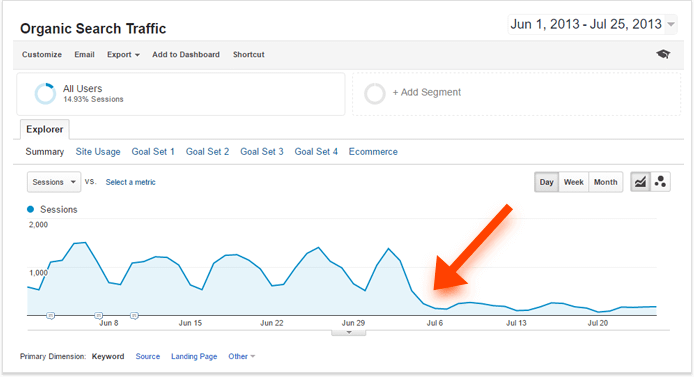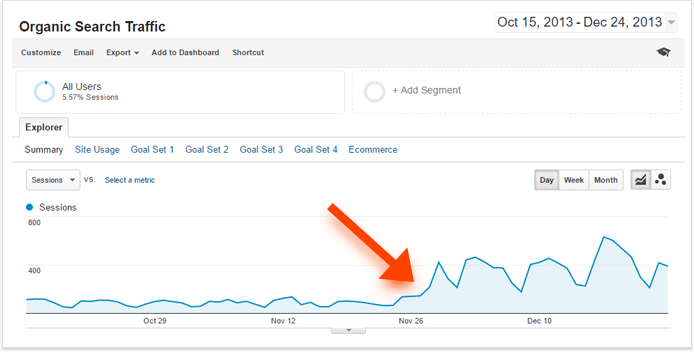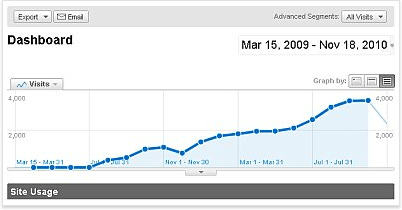4 Real-Life SEO Success Stories To Learn From

(that you can totally replicate)

SEO is a challenge in itself; but for every agency, company, and webmaster trying to get it right, the process of search engine optimization is also full of smaller, less common challenges, specific to their business and industry. This holds true for businesses of every kind and size, from fortune 100 companies to small firms run by a single person, and from reputable well-established websites to one-week-old sites that were just built from scratch.
In this article, I’ve collected real-life SEO success stories about 4 very different businesses that managed to overcome the challenges on their way to top search engine rankings. Read on to find out which obstacles came their way, what helped them succeed, and how you can use their strategies to shape your own SEO success story.
Story #1: Recovering from a manual Google penalty
Background: The website was among the first unlucky sites to receive a manual penalty from Google for user-generated spam, losing 95% of its organic traffic.
Objective: Recover from the penalty and regain rankings and traffic.
The challenge: An unfamiliar penalty no one knew how to deal with
Back in 2013, the exact site you are now on received a manual penalty for user-generated spam. It started with one message from Google:
“Google has detected user-generated spam on your site. Typically, this kind of spam is found on forum pages, guestbook pages, or in user profiles. As a result, Google has applied a manual spam action to your site.”
When we received the notification, we did not take it seriously right away. There was no visible impact on our traffic and rankings, so we carried on as usual. But two weeks forward, dozens of our traffic keywords lost 10 to 20 positions in Google. That’s when we knew we needed to act.
The problem was that at the time, no one really understood how to handle the issue: ours was one of the first sites to receive a penalty of this kind, and there were no blog posts or how-to articles on how to recover. We had to rely on the oblique bits of information we got from Google’s webmaster guidelines and interviews with Matt Cutts. We did exactly what those bits said: took on a (very basic) cleaning mission to remove the outright spammy comments on our blog and forum, and soon sent a reconsideration request to Google with a somewhat impatient, if not rude, cover letter. The letter stated that we are a “reputable company that hasn’t once violated any of Google’s guidelines…”, and are surprised to have received a penalty that we believe is completely undeserved.
It didn’t work: we got a reply saying that the website was still a source of user-generated spam. In the meantime, our rankings across all keywords continued to drop. We did a few more attempts to clean up the spam and sent several other reconsideration requests, none of which was satisfied. Things were getting worse every day, until we realized we had lost a whopping 95% of all organic traffic to the site.

The solution: Comprehensive spam protection
A few months with literally no organic traffic had a massive impact on our sales. Our one-off attempts to clean up the forum weren’t working - we knew we needed to tackle the spam issue in a more comprehensive manner. After removing all even remotely spammy comments from the forum and blog, we traded off a little user experience in favor of better spam protection. Here are the main tactics we implemented to keep our site safe from user-generated spam:
- Make it harder for spammers to register a new account (by requesting an email confirmation or displaying a CAPTCHA).
- Set posting limitations for newly registered users.
- Manually moderate the first posts and comments by new users.
- Switch all user-generated links to “nofollow” to deter spammers from posting.
- Introduce a blacklist to ban repeat spammers by IP address.
- Monitor the forum and blog daily for instances of spam (we continue to do that to this day).
In the meantime, we also took the time to brush up all other aspects of SEO on our site, both on-page and off-page, fixing technical issues and disavowing every unnatural link in our profile to make sure our site overall is as Google-friendly as it gets.
Finally, when we were positive user-generated spam was no longer an issue, we sent in another reconsideration request to Google, describing all the work we had done. This final request was a success. The penalty was removed, and we saw positive results after a couple of days already. Gradually, our most important money keywords started rising back to their original positions.

Within literally a few days after recovery, we had regained around 50% of our top rankings and organic traffic. Organic visits to the site rose to around 400 daily sessions.
Story #2: Competitive research as a top SEO tactic
Background: The site was built specifically for an SEO contest and ended up as one of the winners. Contestants were required to register a brand new domain that they had to rank in Google for the same keyword (Club Penguin Walkthrough) in under 90 days.
Objective: Rank a site in Google for the given keyword to win up to $9,000 in prizes.
The challenge: Ranking a new site in an unfamiliar industry
Scott Paxton was one of the winners in the ApexForum SEO contest were the participants were required to register a brand new domain and rank it in Google.com for the same keyword (Club Penguin Walkthrough) that they were given on the first day of the contest. Every day throughout the contest, each candidate ranking in the top 100 got "100 - their position" number of points. So if you ranked #1, you got 99 points, and if you ranked #99, you got 1 point. The participants with the highest total score over 90 days became the winners and got up to $9,000 in prizes each (along with the glory of winning a huge SEO contest as a sweet bonus).
The solution: In-depth competitive research
While Google’s major ranking factors apply to every industry, the part each plays and the specifics of how it works may vary a lot from niche to niche, especially now in the light of Google RankBrain update. Today, Google might analyze the pages with the best user experience metrics from its search results and look for common traits that make those pages a good fit for a certain query.
When Scott was building his site, he analyzed the top ranking pages in the industry in a similar manner. He dove deep into site structure, content, inner linking, keyword optimization, and backlinks. You can run a similar analysis with SEO PowerSuite: WebSite Auditor will help you explore competitors’ site structure and on-page optimization techniques; SEO SpyGlass will give you a breakdown of competitors’ link profiles (number of links and referring domains, anchor text stats, etc), and Rank Tracker’s Keyword Research module is the best way to do keyword research as it will help you figure out which keywords your competitors are targeting (use Google AdWords – by Target Page and Competition Research suggestion methods for insights).
Here are Scott’s main takeaways from his analysis:
- Inner page ranking. 100% of sites ranked for the search phrase were inner site pages, not the homepage.
- Inner linking. Top ranking sites shared a similar inner linking scheme: the main walkthrough page typically linked to more specific individual Mission pages.
- Keyword optimization. The keyword was found blended into phrases with very rare exact match occurrences. Broad keyword match was common within the meta tags, image alt tags, and headings.
- Content. Keyword score was relatively low within content.
- Backinks. For this niche, Scott observed a higher than usual blended and related anchor ratio and very few exact-match anchors. This helped him formulate his link building plan and understand which anchors he should be aiming to get.
With these insights in mind, Scott got a domain name and built a WordPress site, with a simple design for a basic fan site look.

Since he had no time to lose in the 12-week contest, he sent in traffic signals to the site to make sure it gets indexed quickly (it’s confirmed that Google uses stats from Chrome on sites’ traffic for indexation and rankings). He then incorporated the insights he got from competitive analysis into his own site structure, link building campaign (check out some other great tactics from link-building experts), and content (hint: if you’re optimizing pages with SEO PowerSuite’s WebSite Auditor, the app will automatically dig into your top 10 competiors’ content and calculate the on-page stats for you, like keyword usage and content length, and will then give you SEO tips based on this data).
Competitive research and pattern analysis helped Scott walk away with several of the top prizes in the contest. He managed to rank the main keyword higher than anyone else in the contest, end with most days ranked in Google’s top 5, and get more organic traffic than any other participant.
Story #3: SEO from scratch for a one-person business
Background: The site was built from scratch by the owner as a blog about web development and WordPress.
Objective: Attract organic traffic to the new site by getting to top positions in Google.
The challenge: A brand new site in a highly competitive niche
When Emerson, the site owner, started his website on PHP development and WordPress back in 2009, he got himself into a pretty competitive niche. Like all other new websites, php-developer.org initially had zero traffic. More to that, Emerson had to handle the development, content, and SEO on his own. By using DIY strategies for search engine optimization, he managed to get the website to rank #1 for highly competitive keywords (like “php developer”) in Google.
The solution: Proper groundwork
When you’re building a new site, you’re obviously at a disadvantage against competitors who have well-established websites with hundreds of backlinks already. However, building a site from scratch also has its pros that are rarely talked about when it comes to SEO.

While Emerson definitely employed all kind of on- and off-page SEO tactics throughout his campaign, he also did a lot of work before the site ven went live.
At the prep stage, the author achieved these 3 major wins that he believes massively helped both the site’s SEO and its user experience:
1. Registering a good domain name. One bonus of registering a brand new site is that you get to pick the domain name. Emerson selected php-developer.org for his site because it has the following benefits:
- It directly relates to his content, services and expertise.
- It’s short and easy to spell and remember.
- It contains a keyword that can benefit the site’s rankings and lets visitors know right away what the website is all about.
The length of time for which you register your domain name is not a factor in Google rankings, nor is the registrar you choose to go with; all of this is up to your budget.
2. Selecting an SEO-friendly platform. SEO-wise, Emerson’s main criteria for choosing his blogging platform were the following:
- It should be flexible and easy to edit for on-site SEO.
- It should have fairly good reviews and recommendations from SEO professionals.
- The platform must be secure and constantly updated.
- It has to be easy to set up.
- Ideally, it should also be free or open source.
The author chose WordPress: it’s simple to edit and customize with a lot of time-saving plugins to help you with SEO. Many search engine professionals use and recommend WordPress, including Matt Cutts. WordPress is frequently updated by the developers, and, best of all, it’s free.
3. Picking a web host with quality uptime. There are a lot of web hosts to choose from, but selecting a hosting provider with poor uptime can adversely affect your visitors’ experience as well as your rankings. Here are the most important things to consider when selecting a web host:
- Reviews and ratings, which you can find abundantly online (you can start here).
- Your hosting account should be paid - free web hosting does not do any good if your aim is to increase traffic from search engines over the long term.
- Shared hosting is enough. You do not need a dedicated hosting or VPS account to get started.
- Technical requirements. php-developer.org needed to use PHP as the server-side script, which meant that the web host must use the Apache web server, the Linux OS, PHP, and the MySQL database. Know your own technical requirements and consider them when evaluating a web hosting company. Make sure to avoid these outdated SEO practices.
When the foundation was laid, Emerson moved on to the traditional SEO tactics – on- and off-page – and in under a year managed to grow his organic traffic up to over 1,000 monthly visits.
Story #4: Using site auditing to boost inbound sales
Background: Initially, the site was gaining traffic only through PPC and had 0 rankings in Google for industry keywords.
Objective: Top 10 rankings for ~400 product brand names to boost sales and cut the PPC costs.
The challenge: Non-indexed pages and other tech issues
This success story is one of the case studies made by our friends at the SUSO agency. At the very beginning of their campaign for a new client, SEO experts at SUSO performed a detailed technical website audit with the help of SEO PowerSuite’s WebSite Auditor. This audit identified a number of key areas for improvement:

- The 404 page was not set up correctly.
- There was a large number of broken internal links.
- The site suffered from duplicate content issues.
- 80% of the site's pages were for some reason restricted from indexing.
- A large amount of on-page content hidden behind 'read more' dropdowns was not being indexed.
- Most of the product pages had numerous rel="canonical" tags pointing to different pages.
Additionally, there was a big chance Google's Panda algorithm could also be affecting the site's visibility in search due to low quality content on product pages.
The solution: A Google-friendly site with keyword-optimized landing pages
SUSO worked with the client's in-house team to fix the problems found in WebSite Auditor's report. To be more specific, they set up a custom 404 page, fixed the numerous broken links, edited robots.txt to allow indexation of the important parts of the site, and removed the superfluous rel="canonical" tags (while adding rel="canonical" to pages with duplicate content warnings). To keep the site safe from Panda, the agency added unique images to product pages and offered limited-time discounts to customers in exchange for detailed product reviews to keep the content fresh and original.
The on-site analysis and page auditing helped get the site’s important pages indexed in 1 week; rankings and traffic started to grow quickly. In 3 months, the site went 3,147 places up in Google across all keywords, outranked 9 of its 10 authoritative competitors for most keywords, and grew its sales by over 200%.
As you can see from the stories above, taking care of simple details consistently pays off. Proper preparation, SEO technical audit, tried and tested off-page strategies, and careful analysis of your competition are the basis of any success story in SEO for businesses of any size.
Do you also have a search engine optimization success story you’d like to share? As always, I’m looking forward to some great discussion in the comments.

By: Masha Maksimava

